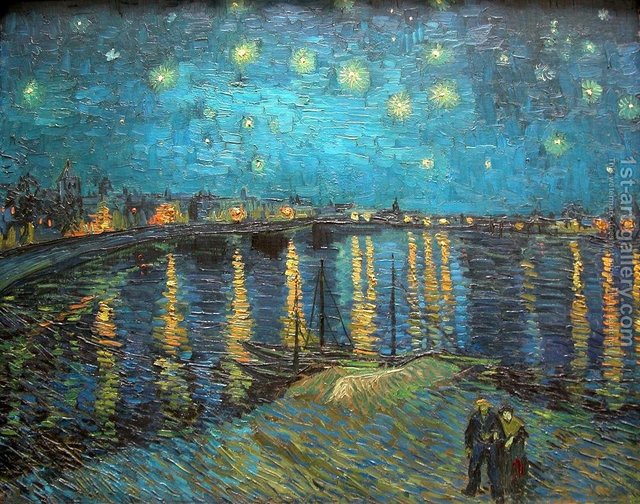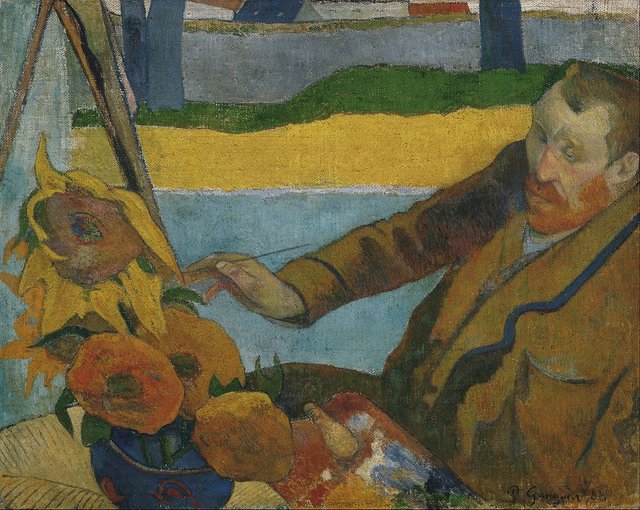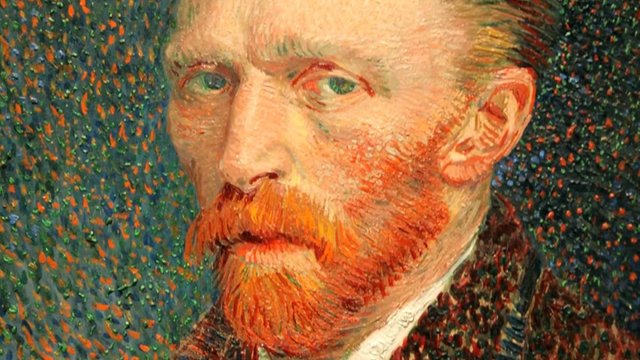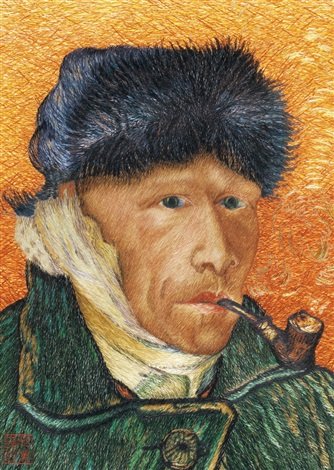ADSactly Culture - The Life of Tortured Artists #1 (Vincent Van Gogh)
Hello again, dear @adsactly readers. Last week, when I was running my series on Wrongfully Maligned Figures in History (which you can check out here, here and here), someone made a really interesting suggestion. She said that she was really enjoying the series and would I write one on the “madness” of writers and artists, you know, sort of debunking those stories as well. (Thank you, @prettyleka for the suggestion!)
But upon further research into this subject, I realized it would be a bit hard to run that proposed series. Why? Well, because all of the famously “mad” artists out there were… actually… pretty mad. Well, not exactly mad, they had various psychological issues, but it would be really hard to debunk their stories, to prove that their tortured artist personas are just in people’s heads.
They really were tortured artists, and albeit quite dark, I do believe their histories are interesting ones that deserve to be explored a tiny bit further. And something I do believe deserves to be debunked is this romantic notion of the tortured artist.
First, a note on the concept of “tortured artists”. According to Wikipedia,
Tortured artists feel alienated and misunderstood due to the perceived ignorance or neglect of others who do not understand nor support them and the things they feel are important.
And this is an image we as a society have been in love with for ages now. Even though it’s quite wrong, as these are very tormented people we’re talking about. But I guess there’s just something awfully romantic about this idea of someone suffering so much for their art, for their uniqueness…
1. Vincent van Gogh

Image
Interestingly, it is a self-portrait of Van Gogh that greets you when you go unto the ‘tortured artist’ Wikipedia page. You can’t say tortured artist without at least thinking of the great painter and even though people tend to romanticize him, his life was not a happy one.
Like many artists, Van Gogh was not understood and was largely unsuccessful during his own lifetime, which understandably led to frustrations. After taking up painting at the suggestion of his beloved brother, Theo, Vincent Van Gogh lived in horrible poverty, often spending what little money he had on brushes and colors, rather than food. As a result, his health deteriorated greatly and pretty quickly (his heavy use of tobacco and alcohol surely didn’t help).
Van Gogh seems to have had a difficult personal life. At first falling in love with his older, widowed cousin, Cornelia Vos-Stricker, whom he even proposed to. But Cornelia rejected him (very possibly because of his poverty and inability to support a family, since Cornelia at the time had an eight-year old daughter). Van Gogh became obsessed with the woman, following her and hanging outside her house.
After this episode, Van Gogh took up living with a prostitute and her two children (neither of them fathered by Vincent), much to his father’s displeasure. He tried revolting against his father and staying with them. But in the end, he left them behind also, possibly because of their meager living conditions and her profession. Later on, the woman drowned herself and Van Gogh went back to living with his parents.
The Ear Incident
During all this, Vincent was developing his style as an artist and finding his own way. He traveled and stayed with different artists. In 1888, he was visited by renowned painter Paul Gauguin, whom he greatly admired. Gauguin stayed with Van Gogh for a while and they painted together, having a sort of mentor-apprentice relationship going. But the atmosphere was becoming tense. Van Gogh understood his own talents and longed for recognition, which Gauguin was unwilling to give, treating Vincent as inferior. Their relationship was a very complex one.
Vincent longed to be rid of the older painter while at the same time, wishing to show his own value and have him around as mentor. It’s unclear how exactly the incident happened.
Gauguin said that Vincent, realizing his mentor was wishing to leave, followed him out one morning (when Gauguin was going for a walk) and threatened him with a razor blade. After the skirmish, it is supposed Van Gogh went back into the house and suffered a breakdown, which led to his severing his right ear.

Vincent Van Gogh Painting Sunflowers - by Paul Gaugain Image
After this episode, Van Gogh’s mental health rapidly unraveled. He stayed in various mental clinics and hospitals and continued his painting throughout. He felt alienated from the world, often complaining of loneliness and extreme sadness, sentiments he channeled into his artistic work.
Sadly, Vincent van Gogh shot himself in the chest on the 27th of July 1890, in a field outside his home. Interestingly, the bullet missed any of his vital organs and didn’t produce any massive damage (he went on to live for some 30 more hours), and it is believed he died from an untreated infection resulted from the shooting.
While his precarious mental health surely wasn’t a good thing, it seems naive to say it is the only reason for Vincent’s demise and sad life. Loneliness, lack of recognition, poor diet and alcohol and tobacco abuse and overwork surely worsened his condition.
Although our account of this great man’s life is brief, it can be surmised that he did not lead a happy, well-balanced life. He lived in poverty, loneliness and his genius was largely unrecognized. Not a romantic picture, at all. It is worth remembering that although the collective idea we have about the tortured artist is a beautiful, if melancholic one, the reality is often bleak and deeply upsetting.
This was supposed to be the only post on the subject, containing multiple cases of “tortured artists”, but the truth is, the subject is so vast and interesting that it’s very hard to cut down on their stories. You can’t really read two paragraphs about a character and even begin to understand what went on in his life. And so, this is the first in a series on tortured artists.
Who is your favorite “tortured artist”?
Authored by @honeydue
References - Wikipedia
Click on the coin to join our Discord Chat

Witness proposal is here:
Go To Steem Witness Page
In the bottom of the page type: adsactly-witness and press vote.

Use small letters and no "@" sign. Or, click here to vote directly!
Thank you!


Good to know!
Thank you so much! I'm really happy that you liked my suggestion. I read every your post with a great pleasure!
Posted using Partiko Android
I really did :) And it opened up a whole lot of interesting stories, so thank you!
I'm glad you're enjoying these :)
The figure of the tormented artist stands out with Romanticism (some of that I wrote in the posts I dedicated to him in this blog); but, obviously, it already existed. Romanticism drives it by emphasizing the rebellion of individuality. That romantic vision, in the strict sense of the word, expands throughout modernity.
Goethe, in speaking of genius, was already recognizing that special condition of the artist in the world in which he lived. Later, the conception of "normality" will be questioned by Freudian and Jungian psychology, and other thinkers such as Foucault.
VanGogh's life will be marked by his genius and conflicts. Very expressive and beautiful are the letters to his brother, collected in the book Letters to Theo. A quote: "I don't know a better definition of the word art than this one: 'Art is man added to nature'; nature, reality, truth, but with a meaning, with a conception, with a character, that the artist makes stand out, and to which he gives expression, 'that redeems', that unravels, liberates, illuminates".
Thanks for your post, @honeydue. I think it will be an interesting series. Greetings.
Yes, but the concept of normality, questionable or not, is still something that plagues us (artists and non-artists alike) each day. Because for better or worse, our society works on this normality, so we have to somehow tie into it.
I haven't had the pleasure of reading his full letters to Theo, but after writing this, they are definitely on my to-read list. That is such an amazing quote, though. I love it, thank you for sharing!!
Thanks for commenting, as always! Hope you enjoy the rest of the series :)
I do not want to fall into clichés, but it is curious that many of the great universal artists tend to be depressed, manic, alcoholic or drug addicts ... I think much of his work is due to that parallel world and their lives disturbed. There is a kind of germ in the madness and in the overflow sensitivity an artist has. In particular, Sylvia Plath is a writer who echoes in me. His life, his disorders, his death always worry me. His head in the oven and children's breakfast prepared as if he were just going for a walk, he tells me about a woman who was very bad and very lonely. To all this, I see that there is a kind of morbid on the part of others, who idealize the madness of the artist only when they have died. This series is interesting, @honeydue. Thanks for sharing!
Yes, Sylvia was tragically plagued by sadness throughout her life. In an interesting coincidence, I wrote about Sylvia in the next installment of the series :) You might like that. But yeah, it's a terrible story. I got to feeling very down while writing about her. More so than any of the other figures in this series...
I've heard it said by some that Plath didn't really intend to kill herself, that it was a cry for help and she meant to be found (there was a man who called there everyday and she meant for him to find her while still alive), sadly, the evidence and the way she isolated her children's rooms suggests otherwise.
Anyway, yes, you're very right. Both Van Gogh and Plath (as well as many others, of course) only became admired artists and were considered geniuses after their suicides, which is a real shame.
Touching life story
the fate of an artist who feels alienated and deprived of his optimism and ends tragically. Vincent felt there was nothing to be expected from this suction so that he felt in solitude. Even though we know that there is high intelligence but when his soul is shaken and feels futile in life, they will choose to end his life.
A tragic story that we can take a lesson, that in one's career, in a love story one must still see something as a reality. As in Vincent's story when he was rejected he became depressed and felt he had no self-respect. when his works have not been appreciated and then feel useless what has been done, it is a problem.
For this reason, in this journey of life we see things with common sense, so that it will be better.
Thank you @honeydue
Thank you @adsactly
Thank you Steemit
Warm regard from Indonesia
Great. The ear incident is interesting to read of